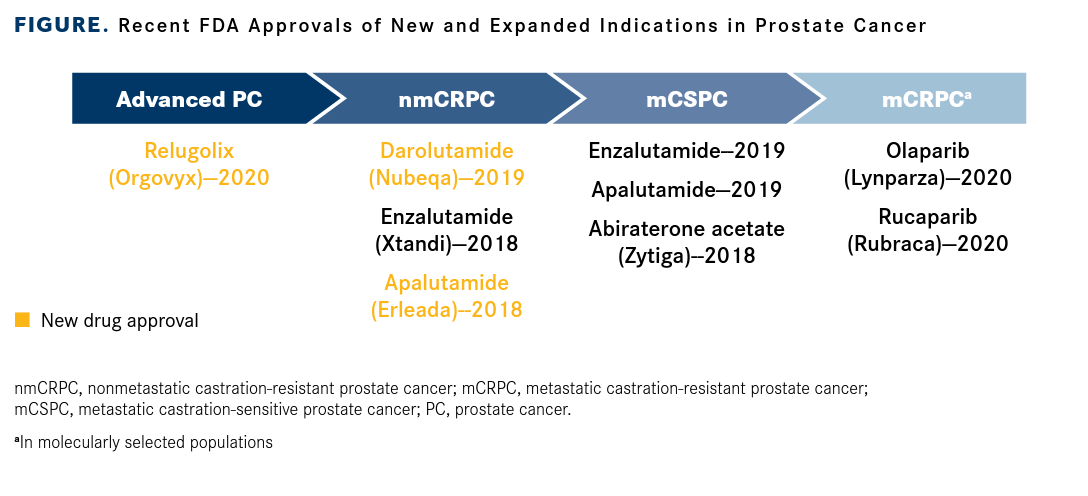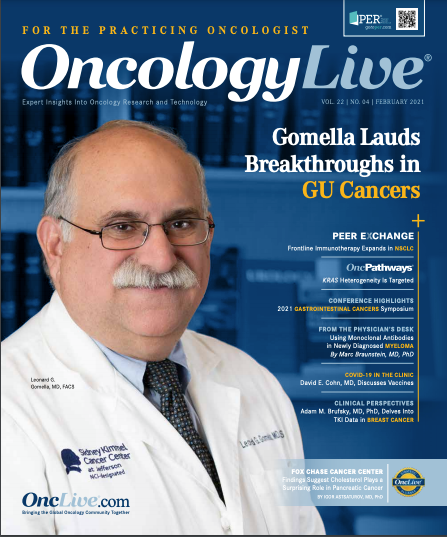Gomella Lauds Breakthroughs in GU Cancers
A recent wave of drug approvals for treating prostate cancer in earlier disease states, coupled with genomic advances, may help pave the way for a shift toward handling the malignancy as a chronic condition.
Leonard G. Gomella, MD, FACS

A recent wave of drug approvals for treating prostate cancer in earlier disease states coupled with genomic advances may help pave the way for a shift toward handling the malignancy as a chronic condition, according to Leonard G. Gomella, MD, FACS.
Starting with the February 2018 approval of apalutamide (Erleada), the FDA has carved out indications for patients with nonmeta-static castration-resistant prostate cancer (CRPC) and castration-sensitive prostate cancer, moving the use of androgen receptor (AR)–targeting agents earlier in the therapeu-tic paradigm.1,2
Instead of focusing on treating men with late-stage prostate cancer, medical and urologic oncologists now have new options to attack the disease earlier in its progression, Gomella noted in an interview with OncologyLive®.
“One of the concepts we talk about in prostate cancer is a shift to the left,” he said, referring to the treatment timeline. “Studies are investigating traditional agents used in advanced disease states and moving them to earlier disease states. In theory, [this would]suppress the progression of prostate cancer so instead of a life-threatening disease it becomes a chronically managed disease like diabetes or hypertension—that’s where a lot of the research is going,” Gomella said.
“The field is investigating drugs that may alter that trajectory of prostate cancer by doing more work on the cancer’s unique genetics and understand-ing the genetic triggers that you may be able to interact with earlier in the course of the disease to either slow progression or even prevent it from metastasizing. Or, once it’s metastasized, leave it there in a holding pattern.”
Gomella, a widely recognized expert in urologic cancers, is the Bernard W. Godwin Jr Professor of Prostate Cancer, and chair of the Department of Urology and senior director clinical affairs at Sidney Kimmel Cancer Center at Thomas Jefferson University in Philadelphia, Pennsylvania.
He will share his insights into new develop-ments in the field during the New York GU™ 14th Annual Interdisciplinary Prostate Cancer Congress® and Other Genitourinary Malignancies conference. Physicians’ Education Resource®, LLC (PER®) will host the meeting virtually on March 12-13.
Gomella will serve as program cochair, joined by Daniel P. Petrylak, MD, professor of medicine (medical oncology) and of urology and coleader of Cancer Signaling Networks at Yale Cancer Center in New Haven, Connecticut, as well as a 2017 Giants of Cancer Care® award winner. The first day of the conference will feature presentations on urothelial carcinoma and renal cell carcinoma, and the second will focus primarily on prostate cancer.
Daniel P. Petrylak, MD

Gomella’s involvement with New York GU™ reflects the leadership role that he has established during his nearly 40-year career in urology. Gomella helped pioneer the use of molecular analyses in prostate cancer through the development of reverse transcriptase–polymerase chain reaction for prostate-specific antigen (PSA) to detect circulating prostate cancer micro-metastases in the early 1990s.3 This work is considered the earliest concept of the “liquid biopsy” being used today. In addition, he led the urology effort for the 2017 Philadelphia Prostate Cancer Consensus Conference that resulted in the first multidisciplinary guidelines on genetic testing for prostate cancer.4
“Dr Gomella has been a major force in urologic oncology,” said Robert Dreicer, MD, director of solid tumor oncology in the Division of Hematology/Oncology at the University of Virginia (UVA) School of Medicine and deputy director of the UVA Cancer Center in Charlottesville, Virginia. “He works in all the major urologic malignancies, but his work in prostate cancer involves translational genomics. He’s been a major contributor with genomics in predicting the risk of localized disease in the role of intervention. And he pioneered multidisciplinary management of prostate cancer. He’s really in the forefront of urologic oncology in 2021.”
FIGURE. Recent FDA Approvals of New and Expanded Indications in Prostate Cancer

KEY DEVELOPMENTS IN PROSTATE CANCER
This year’s New York GU™ meeting will be brimming with new information about best practices and emerging research for each cancer type on the agenda, Gomella said. For example, Dreicer will discuss integrating next-generation antiandrogens and chemotherapy into treatment plans for patients with metastatic prostate cancer.
Several groundbreaking developments in prostate cancer that occurred during 2020 will be covered. These include approvals for the PARP inhibitors rucaparib (Rubraca) and olaparib (Lynparza), the first oral molecularly targeted therapies for this tumor type; relugolix (Orgovyx), the first oral gonadotropin-releasing hormone (GnRH) receptor antagonist; and Gallium 68 PSMA-11 (Ga 68 PSMA-11), the first drug for positron emission tomography (PET) imaging of prostate- specific membrane antigen (PSMA)–positive lesions in men with prostate cancer.
The 2 recent PARP approvals for prostate cancer, which occurred within a 5-day period in May 2020, “are opening up a whole new spectrum of oral agents for the management of advanced prostate cancer,” Gomella said.
Rucaparib received accelerated approval for adult patients with metastatic CRPC with germline or somatic BRCA mutations who have been treated with AR-directed therapy and a taxane-based chemotherapy. The decision was based on results from the single-arm TRITON2 trial (NCT02952534), in which rucaparib demonstrated an objective response rate of 44% (95% CI, 31%-57%) in 62 patients with measurable disease. Participants received rucaparib 600 mg orally twice daily along with a GnRH analog or had prior bilateral orchiectomy.5
Olaparib is indicated for adult patients with metastatic CRPC harboring a germline or somatic mutation in a homologous recombination repair (HRR) gene, including BRCA1/2, who have progressed following prior treatment with enzalutamide (Xtandi) or abiraterone acetate (Zytiga). The drug was approved based on data from the phase 3 PROfound study (NCT02987543), in which patients were randomized 2:1 to olaparib at 300 mg twice daily (n = 256) or investigator’s choice of enzalutamide or abiraterone (n = 131). As in the rucaparib trial, all participants also received a GnRH analog or had prior bilateral orchiectomy.6
Participants were divided into 2 cohorts based on mutation status: cohort A for those with mutations in BRCA1/2 or ATM and cohort B for those with mutations in 12 other genes associated with HRR. Radiological progression-free survival (rPFS) in cohort A, the primary end point of the study, was a median of 7.4 months (95% CI, 6.2-9.3) among those who received olaparib versus 3.6 months (95% CI, 1.9-3.7) for patients who received investigator’s choice of therapy (HR, 0.34; 95% CI 0.25-0.47; P < .0001). The median overall survival was 19.1 months (95% CI, 17.4-23.4) with olaparib versus 14.7 (95% CI, 11.9-18.8) with investigator’s choice (HR, 0.69; 95% CI, 0.50-0.97; P = .0175). The median rPFS for olaparib in cohorts A plus B also was higher than for standard therapy (5.8 vs 3.5 months; HR, 0.49; P < .0001).6
“PARP inhibitors interfere with the ability of the malignant prostate cancer cell’s DNA HRR mutations to repair itself and continue to grow, so they are a very effective tool,” Gomella said. “PARP inhibitors are considered third-, or fourth-line therapies; these men must have failed other standard therapeutic interventions for metastatic castrate-resistant prostate cancer to be eligible for olaparib or rucaparib.”
The population of patients with advanced disease who could be eligible for PARP therapy represents a significant subset. Study f indings indicate that the prevalence of germline mutations in genes regulating DNA repair processes in men with metastatic prostate cancer is at least 11.8%, including 5.3% with BRCA2 and 0.9% with BRCA1 mutations. In men with localized high-risk disease, the incidence of HRR genes was 6%.7
Additionally, the FoundationOne Liquid CDx assay has been approved as the companion diagnostic to detect relevant mutations for both PARP inhibitors. The next-generation sequencing tool is a liquid biopsy capable of analyzing circulating cell-free DNA isolated from plasma derived from peripheral whole blood of patients with cancer.8
“Developments in biomarkers and genetics have been explosive,” said Gomella, who will be giving a presentation on this topic. “We now have circulating tumor DNA that can be evaluated in patients with prostate cancer to determine genetic susceptibility to new medications. This is a big breakthrough.”
Relugolix, approved in December 2020 for patients with advanced prostate cancer, is the most recent arrival on the scene. The FDA based its decision on findings from the phase 3 HERO trial (NCT03085095), in which relugolix demonstrated superiority over leuprolide (Lupron) in terms of sustained testosterone (T) suppression through 48 weeks, T recovery following discontinuation, and a 50% reduction in major adverse cardiovascular events (MACE). Leuprolide, a luteinizing hormone-releasing hormone (LHRH) agonist, is administered subcutaneously, as are other androgen deprivation therapy options.9-11
The sustained castration rate with relugolix was 96.7% (95% CI, 94.9%-97.9%) versus 88.8% (95% CI, 84.6%-91.8%) with leuprolide, for a 7.9 percentage point difference between the therapies. T recovery to at least 280 ng/dL at 90 days was 54.0% with relugolix versus 3.0%, and the cumulative incidence of MACE was 2.8% versus 5.6%, respectively.9,10
Gomella said that relugolix will be an important part of discussion at New York GU™ given its recent addition to the treatment paradigm. “The HERO trial demonstrated that relugolix had excellent suppression of testosterone,” Gomella said. “And, as an oral antagonist, it showed a very rapid decline in testosterone in the studies. It’s another brand-new option in prostate cancer. Urologists are going to have to become familiar with this new agent and how to choose the optimum patient for the use of this oral agent for androgen deprivation therapy. While urologists are very comfortable with injectable agents to lower testosterone, this formulation is something that we’re not used to using in daily practice.”
Relugolix also has the advantage of coming in tablet form, as opposed to degarelix (Firmagon), the only other FDA-approved GnRH receptor antagonist, which is administered monthly as a subcutaneous injection in the abdominal region. “Since relugolix is an antagonist, you do not see a surge in testosterone at week 2 that you see with the LHRH agonists,” Gomella said. “So there is some benefit to using an antagonist in certain settings.”
In terms of imaging, the impact of the FDA approval of Ga 68 PSMA-11 in December 2020 will not be widely available in clinical practice but it is a noteworthy development nonetheless, Gomella said. The radioactive diagnostic agent, which is administered as an intravenous injection, is indicated for patients with suspected prostate cancer metastases who are considered potentially curable by surgery or radiation therapy. It also is indicated for patients with suspected recurrence based on rising PSA levels.12
As it stands now, Ga 68 PSMA-11 is only approved for use at the University of California (UCLA), Los Angeles and UCLA, San Francisco, where studies have taken place. Outside of a clinical trial at other centers, the California sites are the only locations authorized in the United States for the diagnostic, although Gomella said it has been available for some time in Europe, Australia, and New Zealand.
“PSMA PET scan is designed to pick up metastases from prostate cancer at a very low PSA level, and a very low volume of metastases compared to traditional agents such as MRIs, CAT scans, and bone scans. While other PET agents for prostate cancer are available, PSMA PET imaging is something that’s going to be commonly utilized as it becomes more widely available in the United States,” Gomella said.
In a comparative study (NCT03515577), UCLA investigators evaluated 50 patients with biochemical recurrence after a radical prostatectomy with low PSA levels with the standard 18F-fluciclovine PET-CT scan and the PSMA PET-CT. The PSMA scan detected recurrences of prostate cancer in 56% of scans, compared with 26% with the fluciclovine scan, for an odds ratio of 4.8 (95% CI, 1.6-19.2; P = .0026).13 “Hopefully, there will be other centers around the United States that will be eligible to jump on their FDA approval,” Gomella said.
A related approach under investigation is the use of PSMA-based theragnostics. This approach combines therapeutic and diagnostic functions in the management of metastatic prostate cancer, Gomella said. One such agent under study is lutetium-177labeled PSMA-617 (LuPSMA), a radionuclide therapy that significantly improved PSA response compared with cabazitaxel (Jevtana) in men with metastatic CRPC whose disease progressed after docetaxel treatment (N = 200) in the phase 2 TheraP study (NCT03392428). The reduction in PSA, defined as 50% or greater from baseline, was 66% (95% CI, 56%-75%) in the LuPSMA arm versus 37% (95% CI, 27%-46%) with cabazitaxel, for an absolute difference of 29% (95% CI, 16%-42%; P < .0001).14
“Using the theragnostics approach, a prostate cancer avid antibody finds the cell, and there’s a radioactive payload that’s associated with it,” Gomella said. “And once that antibody binds to the malignant cell, a radioisotope such as lutetium-177 kills the cancer cells.”
UROTHELIAL CARCINOMA
Gomella said there will be several topics on tap at New York GU™ involving advances in bladder cancer. These include treating patients with high-risk, non–muscle invasive bladder cancer (NMIBC) who are not responsive to BCG with pembrolizumab (Keytruda). In January 2020, the FDA approved pembrolizumab monotherapy in this setting for NMIBC with carcinoma in situ with or without papillary tumors.15
The approval was based on findings from the KEYNOTE-057 trial (NCT02625961) involving 96 patients who had undergone transurethral resection of bladder tumor (TURBT) to remove all resectable disease. The complete response rate for these patients, defined as negative results for cystoscopy with TURBT or biopsies as applicable, was 41% (95% CI, 31%-51%), with a median duration of response of 16.2 months (range, 0.0-30.4+), with 46% of the responders (n = 18) exhibiting a response for 12 months or longer.15
“What was particularly fascinating about this approval is the fact that this is a systemic therapy for non–muscle invasive bladder cancer,” Gomella said. “This is not used as an intravesical agent.”
Emerging therapies generating excitement in NMIBC settings include nadofaragene f iradenovec (also known as rAd-IFNα/ Syn3), an adenovirus vector-based gene therapy that targets urothelial cells, as an alternative to radical cystectomy in BCG-nonresponsive NMIBC.
In a January 2021 publication, Gomella and colleagues reported findings from a phase 3 multicenter trial (NCT02773849), supported by the Society of Urologic Oncology, of nadofaragene firadenovec in BCG-nonresponsive NMIBC. Within 3 months of the first dose, the therapy elicited a complete response in 53.4% of 103 patients (n = 55) with carcinoma in situ with or without concomitant high-grade Ta or T1 disease. Of these patients, 45.5% (n = 25) maintained their response at 12 months.16
“Clinical trials showed that this was a very effective intravesical gene therapy for non-muscle invasive bladder cancer. This is another breakthrough development in NMIBC,” Gomella said.
The FDA is currently evaluating a biologics license application for nadofaragene firadenovec, according to FerGene Inc, the company developing the drug.
Another development that experts will discuss at New York GU™ is mitomycin gel (Jelmyto), which was approved in April 2020 for patients with low-grade upper tract urothelial cancer (UTUC) based on data from the single-arm, phase 3 OLYMPUS trial (NCT02793128). Of the 71 patients treated with mitomycin gel, 58% achieved had a complete absence of tumor lesions 3 months after receiving therapy; 19 of the 41 responders maintained a complete response at 12 months (median duration, not reached; range, 0-8.8+ months).17 The therapy has implications in the management of bladder cancer; Gomella said approximately 10% to 15% of patients with bladder cancer can develop UTUC and 20% to 30% of those diagnosed with UTUC may develop bladder cancer.
“At cool temperature, this agent is liquid but when warm it becomes a gel. This is injected into the upper urinary tract through the bladder,” Gomella said. “This agent has allowed us to maintain the renal unit in many patients with low-grade urothelial carcinoma who otherwise may have no option other than taking their kidney out. So this is another novel urothelial/bladder cancer development that we’ve had over the past year.”
A HISTORY OF TEAMWORK
Throughout his career, Gomella has emphasized a team spirit in oncology care. One of his most prominent efforts in recent years has been leading the urology effort in the Philadelphia Prostate Cancer Consensus, which brings together experts from throughout the United States and abroad to discuss the role of genetic testing in prostate cancer. In 2017, the consensus meeting produced the first comprehensive set of recommendations to guide physicians on when to offer men genetic consultation. Two years later, they reconvened a 2019 consensus in Philadelphia to consider challenges in the execution and education of prostate cancer germline testing.18
Philip W. Kantoff, MD

The 2017 meeting, which took place just a few years after the growing recognition that some prostate cancers were related to genetic risk, was an important milestone, said Philip W. Kantoff, MD, a 2014 Giants of Cancer Care® award winner and chair of the Department of Medicine at Memorial Sloan Kettering Cancer Center in New York, New York.
“That was a very important meeting, not as much scientifically as educationally, because a lot of the people who were invited were urologists who are not as familiar with the importance of germline testing,” Kantoff said. “It has really taken off with regard to testing for more aggressive forms of prostate cancers and looking for DNA repair abnormalities that might be significant.”
Genomic testing is one of the most exciting areas of development in Gomella’s eyes. “Identification of these genetic alterations is giving us another alternative pathway to treat these men who ultimately develop metastatic castrate-resistant prostate cancer,” he said.
More than 20 years before the consensus conferences, Gomella was busy launching other collaborative projects. In 1993, he teamed up with a Philadelphia Inquirer science writer to publish the first book specifically addressing prostate cancer for the public, Recovering From Prostate Cancer.19 In the mid-1990s, he introduced a multidisciplinary clinic at the Sidney Kimmel Cancer Center where patients are able to meet with radiation, medical, and urologic surgical specialists during the same visit. Part of the visit includes evaluation for potential clinical trial participation. Most of the men coming through the multidisciplinary clinic have early prostate cancer and are considering the choice of either active surveillance or intervention, usually with radiation or surgery.
“We’re very proud of this multidisciplinary approach,” Gomella said. “We’ve been doing this approach at the Sidney Kimmel Cancer Center since way back in 1996. We’ve found it to be an amazing experience. We don’t know of any other center that’s been doing it as long as we have. Many other centers have started to do it because it’s a very patient- and family- friendly approach to prostate cancer. We’re all at the same place at the same time to talk to the patient and their family, and then give them our best recommendation for the treatment pathway they should start on.”
In 2014, the multidisciplinary clinic began incorporating an introduction to prostate cancer genetic testing, another first in the f ield. Patients and their families receive an overview of whether pursuing genetic testing is something they should consider after their initial treatment has begun, Gomella said. The goal is to identify patients who have a genetic predisposition not just to prostate cancer but other related inherited malignancies. This includes breast and ovarian cancer in female relatives as well as pancreatic cancer, melanoma, or male breast cancer in the patient or his close family members.
“Testing family members of a patient with prostate cancer is a concept known as cascade testing,” Gomella said. “Is this something that perhaps their children should be aware of, that they might have an inherited genetic predisposition to these related groups of cancer? This requires a very up-close-and-personal discussion with the patient or family. While most patients with prostate cancer do not appear to harbor an inherited genetic risk, 15% to 20% of men may benefit from further genetic evaluation. We believe thoughtful genetic testing and counseling is the future of precision medicine in all of cancer care.”
Another point of pride is the scientific research that Gomella and colleagues have conducted into molecular biomarkers. “When it comes to a basic science discovery, something that usually does not get a lot of attention is something that I’m particularly proud of. In 1992, we described the first molecular test to identify circulating prostate cancer cells in the blood. I think this really laid the groundwork for others who started to investigate whether we can use molecular tests to identify circulating tumor cells and other molecular targets in the blood.”
The research was ahead of its time, he said. “Over the past 25 years, the basic molecular work we did has been eclipsed and expanded dramatically. It was probably too early; we and others who joined in this preliminary prostate cancer work didn’t really fully understand the biology of molecular blood testing.”
FIGHTING THE GOOD FIGHT
Although Gomella has been a driving force in urologic oncology for many years, his early career path was winding and unpredictable. In high school, he figured he would go into engineering, psychology, or medicine. But while attending Queens College at the City University of New York, he became involved in emergency medical services. He ended up founding a volunteer ambulance unit in New York City and decided to focus on emergency medicine. Part of his focus evolved into teaching cardiopulmonary resuscitation (CPR) techniques to medical students. “It’s hard to believe today, but when I was a medical student in the late 1970s, medical students were not routinely learning CPR,” he said.
“Then I had a revelation as a third-year medical student. When you’re in emergency medicine, you spend a lot of time calling trauma surgeons to come to the emergency [department] and care for patients,” Gomella said. “Seeing these trauma surgeons in action f irst hand greatly impressed me. That is when I decided I wanted to be a surgeon.”
After 2 years of general surgery, he migrated to urology. He joked that he made the move because he discovered that a doctor is more likely to remain married after a urology residency than a general surgery residency. But in actuality, he was recruited by the chief of urology, J. William McRoberts, MD, at his training site, the University of Kentucky College of Medicine, who made him realize a urology residency could point him toward research and a career in academic medicine.
Gomella completed a fellowship in surgical oncology in the surgery branch at the National Cancer Institute, where he worked with 2013 Giants of Cancer Care® award winner Steven A. Rosenberg, MD, PhD, and urologic oncologist W. Marston Linehan, MD. In 1988, he was recruited by former dean Joseph Gonnella, MD, to help start a new cancer center at Jefferson and has been there ever since.
“The grass is always greener someplace else, but Jefferson and the Sidney Kimmel Cancer Center have been a great place for me. Many of my colleagues who got their start here have gone on to greatness elsewhere, but there are also a lot of my colleagues who are still here fighting the good fight with us,” Gomella said.
References
- Beaver JA, Kleutz PG, Pazdur R. Metastasis-free survival - a new end point in prostate cancer trials. N Engl J Med. 2018;378(26):2458-2460. doi:10.1056/NEJMp1805966
- Hematology/oncology (cancer) approvals & safety notifications. FDA. Updated January 22, 2021. Accessed January 31, 2021. https://bit.ly/39AwUT5
- Moreno JG, Croce CM, Rischer R, et al. Detection of hematogenous micrometastasis in patients with prostate cancer. Cancer Res. 1992;52(21):6110-6112.
- Giri VN, Knudsen KE, Kelly WK, et al. Role of genetic testing for inherited prostate cancer risk: Philadelphia Prostate Cancer Consensus Conference 2017. J Clin Oncol. 2018;36(4):414-424. doi:10.1200/JCO.2017.74.1173
- FDA grants accelerated approval to rucaparib for BRCA-mutated metastatic castration-resistant prostate cancer. FDA. Updated May 15, 2020. Accessed January 31, 2021. https://bit.ly/3apoWuS
- FDA approves olaparib for HRR gene-mutated metastatic castration-resistant prostate cancer. FDA. Updated May 20, 2020. Accessed January 31, 2021. https://bit.ly/3pCDM7Y
- NCCN. Clinical Practice Guidelines in Oncology. Prostate cancer, version 3.2020. Accessed January 31, 2021. https://www. nccn.org/professionals/physician_gls/pdf/prostate.pdf
- Premarket approval (PMA) FoundationOne Liquid CDx. FDA. November 6, 2020. Accessed January 31, 2021. https://bit.ly/3an7K9C
- FDA approves first oral hormone therapy for treating advanced prostate cancer. News release. FDA. December 18, 2020. Accessed January 19, 2021. http://bit.ly/2Ws5nvz
- Shore ND, Saad F, Cookson MS, et al; HERO Study Investigators. Oral relugolix for androgen-deprivation therapy in advanced prostate cancer. N Engl J Med. 2020;382(23):2187-2196. doi:10.1056/NEJMoa2004325
- Multi-discipline review. Center for Drug Evaluation and Research. FDA. December 18, 2020. Accessed January 31, 2021. https://bit.ly/393bDkn
- FDA approves first PSMA-targeted PET imaging drug for men with prostate cancer. News release. FDA. December 1, 2020. Accessed December 1, 2020. https://bit.ly/3ajr0Vm
- Calais J, Ceci F, Eiber M, et al. 18F-fluciclovine PET-CT and 68Ga-PSMA-11 PET-CT in patients with early biochemical recurrence after prostatectomy: a prospective, single-centre, single-arm, comparative imaging trial. Lancet Oncol. 2019;20(9):1286-1294. doi:10.1016/S1470-2045(19)30415-2
- Hofman MS, Emmett L, Sandhu SK, et al. TheraP: a randomized phase III trial of 177Lu-PSMA-617 (LuPSMA) theranostic versus cabazitaxel in metastatic castration-resistant prostate cancer (mCRPC) progressing after docetaxel: initial results (ANZUP protocol 1603). J Clin Oncol. 2020;38(suppl 15):5500. doi:10.1200/JCO.2020.38.15_suppl.5500
- FDA approves pembrolizumab for BCG-unresponsive, high-risk non-muscle invasive bladder cancer. FDA. Updated January 8, 2020. Accessed January 22, 2021. https://bit.ly/2NX5MW1
- Boorjian SA, Alemozaffar M, Konety BR, et al. Intravesical nadofaragene firadenovec gene therapy for BCG-unresponsive non-muscle-invasive bladder cancer: a single-arm, open-label, repeat-dose clinical trial. Lancet Oncol. 2021;22(1):107-117. doi:10.1016/S1470-2045(20)30540-4
- FDA approves mitomycin for low-grade upper tract urothelial cancer. FDA. Updated April 15, 2020. Accessed January 31, 2021. https://bit.ly/2L5D5F4
- Giri VN, Knudsen KE, Kelly WK, et al. Implementation of germline testing for prostate cancer: Philadelphia Prostate Cancer Consensus Conference 2019. J Clin Oncol. 2020;38(24):27982811. doi:10.1200/JCO.20.00046
- Gomella LG, Fried JJ. Recovering from Prostate Cancer. HarperCollins; 1993.




